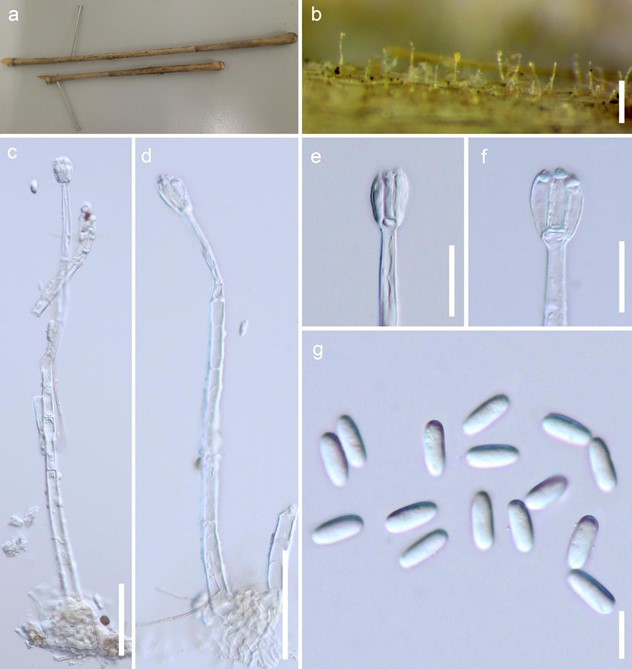Hyalinostachys cylindrospora C.G. Lin & K.D. Hyde, sp. nov. Fig. 235
MycoBank number: MB 555605; Index Fungorum number: IF 555605; Facesoffungi number: FoF 03884;
Etymology – Name reflects the cylindrical conidia. Holotype – MFLU 17-2650.
Saprobic on plant host. Sexual morph: Undetermined. Asexual morph: Hyphomycetous. Colonies effuse, hairy, pale to pale brown. Mycelium partly superficial and partly immersed. Conidiophores macronematous, mononematous, single or in small groups, simple or sometimes branched, erect, straight, septate, thick-walled, smooth, hyaline, up to 310 μm, 4–12 μm, narrower at the apex, bearing a whorl of 4–5 conidiogenous cells. Conidiogenous cells monophialidic, discrete, determinate, terminal, elongate ampulliform, clavate or subcylindrical, the outer ones somewhat curved and ventricose, hyaline, smooth, 13–19 × 3.5–6 μm; conidial mass slimy, pale orange. Conidia acrogenous, aseptate, smooth, hyaline, cylindrical or ellipsoidal, 14–16.5 × 5.5–7 μm.
Culture characteristics: Conidia germinating on PDA in 12 h. Colonies on PDA, reaching 3 mm in 2 weeks at 25°C, flat, dark from above and the reverse. Mycelium immersed in media, composed of branched, septate, smooth, hyaline hyphae.
Material examined – THAILAND, Chiang Mai, Mae Taeng District, Sop Poeng, on decaying wood, 25 September 2016, Chuan-Gen Lin, LCG 11-5 (MFLU 17-2650, holotype), ex-type living culture, MFLUCC 17-2583.
Genbank numbers – ITS: MG717501, LSU: MG717503, rpb2: MK133023.
Notes – This species belongs to family Stachybotryaceae, and its placement is supported by morphology and phylogenetic analysis. Hyalinostachys cylindrospora can be distinguished from other stachybotrys-like species by its hyaline conidiophores and hyaline, cylindrical or ellipsoidal conidia.

Figure 235 – Hyalinostachys cylindrospora (MFLU 17-2650, holotype). a Host material. b Conidiophores on the host surface. c, d Conidiophores and conidiogenous cells. e, f Conidiogenous cells. g Conidia. Scale bars: b = 200 μm, c, d = 50 μm, e, f = 20 μm, g = 10 μm.
